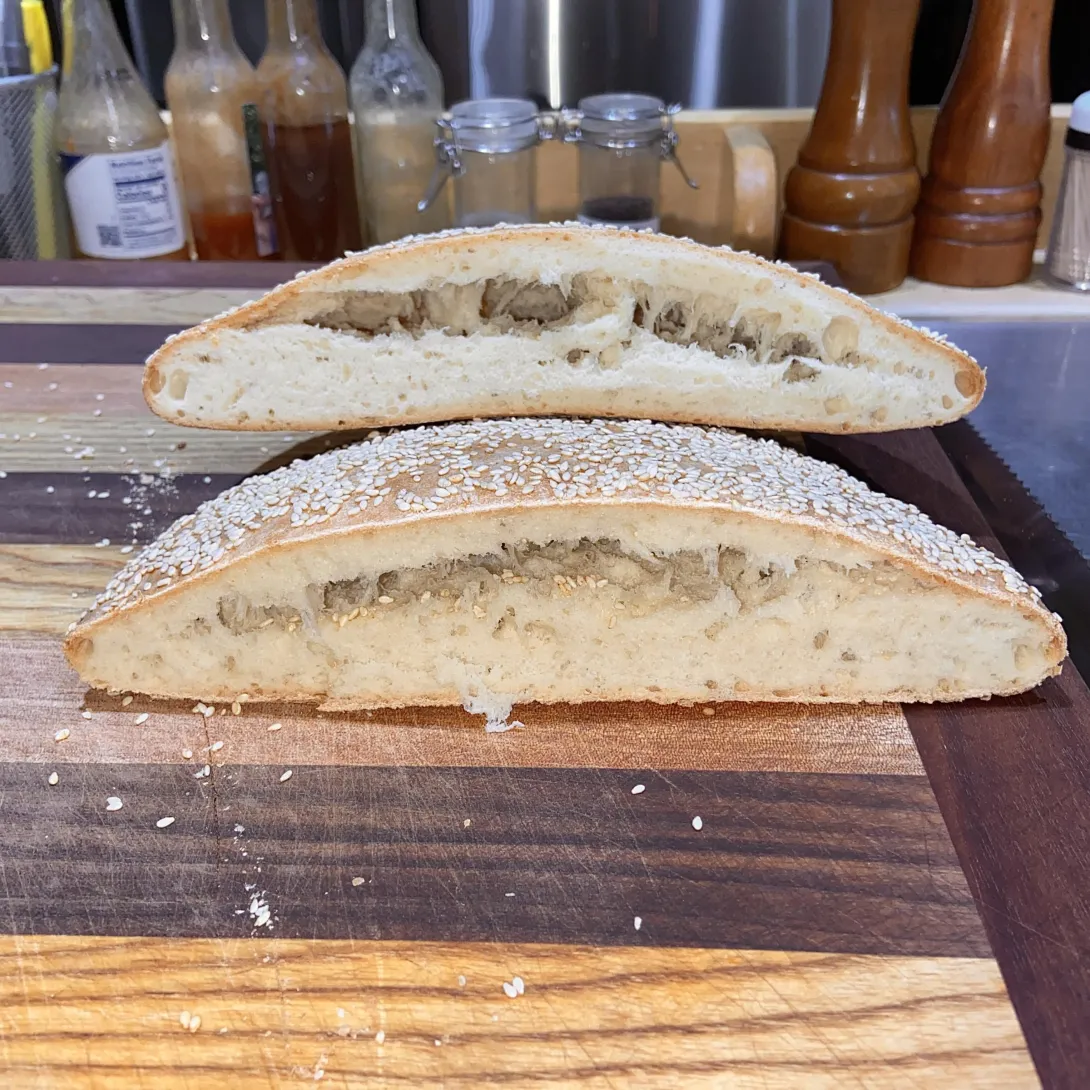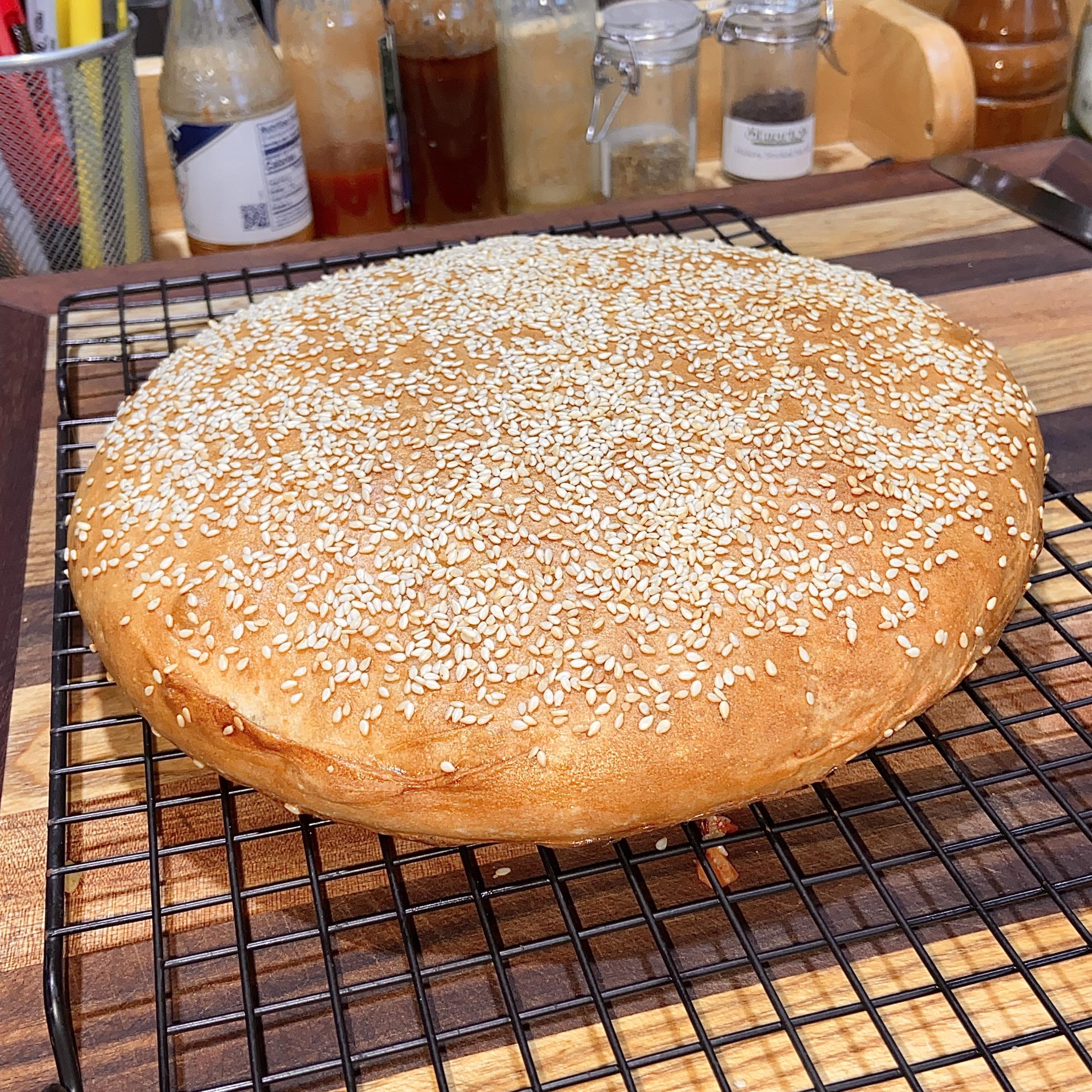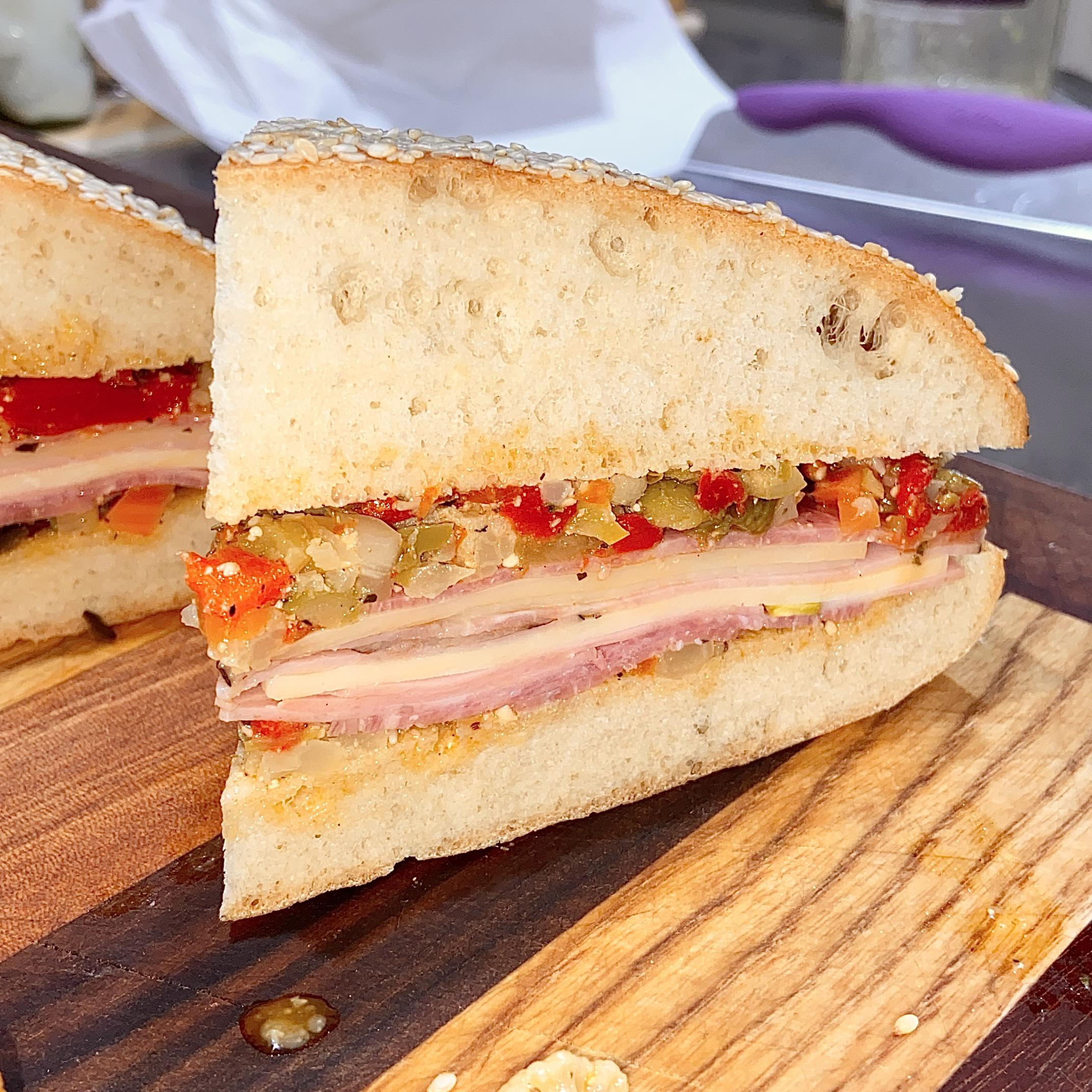
Let me preface by saying Im not a baker by any means. More a lover of Louisiana cooking and thus I make muffuletta sandwiches from scratch.I have been having inconsistent results with my muffuletta bread for some time now. The problem most recently is these big cavities or air pockets in the bread. The recipe I had been using was;
flour 100%
water 58%
IDY 1%
Kosher salt 2%
olive oil 2%
sugar 1.5%
(Baking at 9' above sea level, radiant heat conventional oven)I use high gluten Bouncer flour. Mix ingredients in stand mixer until ball is formed and then hand knead for another minute, then bench rest covered for 20 minutes (water was 70°F). After 20 minutes, I roll into a tight ball and place in proofing pan for 1 hour. After 1 hour I flatten the ball into a 9" round on parchment paper on a baking sheet, eggwash and sesame seeds. Oven has been preheated to 450°. I bake for 10 minutes at 450° then lower temp to 325° and bake until brown.
I did an experiment yesterday and revised the recipe, but not the technique or oven temperature.
flour 100%
water 56%
IDY .7%
kosher salt 3%
olive oil 4%
sugar 1.5%
I used a 50/50 blend os high gluten flour and ap flour. Hydration was decreased and oil was increased. Oven temps were the same. The pictures I have attached are the results. Big open air pocket in the crumb. Can anyone show me the way to the promised land where I have a consistent dense crumb that is characteristic of muffuletta bread? Thanks.
From the photo the loaf appears underproofed. In addition to the changes you listed (decreased water, increase oil) you also decreased yeast and increased salt. All of those slow dough development. You could also measure dough temp, there was possibly a lower temp that slowed things down and would have rrquired more time. I'd suggest not sticking to a precise timeline as you make changes, monitor your dough and bake when it is ready even if it is more time than last time.
Go back to the he original formula. Go for a bulk fermentation that doubles the volume.
Sicilian muffulaetta bread. Shaped in the traditional eyes of Saint Lucy (occhi di Santa Lucia) shaping.
That is beautiful bread! I will say that it hadn't doubled in size. So do you think a longer proof time where it doubles in size is the answer to why those big cavities are there?
I think yes. If you let the first rise go until a doubling in volume is observed, you will have a better outcome. For the proofing (second rise) start testing at 30 minutes. Use the poke test to gage proper proofing. Google the poke test. It's easy.
From the photo the loaf appears underproofed (So when you say underproofed, do you mean I should have let them proof for additional time? If so, how do I know how long). In addition to the changes you listed (decreased water, increase oil) you also decreased yeast and increased salt. All of those slow dough development (I decreased yeast because I assumed too much would cause too much rise in the bread). You could also measure dough temp, there was possibly a lower temp that slowed things down and would have rrquired more time (So if I measure the dough temp, what is the ideal temp I should be looking for?). I'd suggest not sticking to a precise timeline as you make changes, monitor your dough and bake when it is ready even if it is more time than last time (I need more information on "when it's ready". As I mentioned, I am bot a baker by any means and that is why I am posting here, to try and figure out how to fix this).
I concur with the poke test mentioned above. Here's one web reference: https://www.theperfectloaf.com/how-to-use-the-dough-poke-test/
Also other things to look for might be:
-a substantial rise (the exact amount isn't super important),
-smoothness in the dough surface, bubbles at the surface, and for the dough to jiggle when shaken (it's not too tight)
Good luck on your next bake! Underproofing happens!
New test in process. Im going back to the original recipe. The water ia 105° this time and Im gonna proof til it doubles in size and see what happens. To be continued.
I have never baked this kind of bread but I notice a couple of things in the recipe.
If you bake when the dough is underproofed, but fermentation is well under way, the dough will tend to rise strongly when baked. The tearing of the bread suggests a strong rising potential. The high baking temperature might have hardened the surface so it couldn't expand much, and the only other place that could expand would be the separation in the middle.
This is only a guess, but I would lower the baking temperature and increase the water.
TomP
We need to be on the same page.
Since you expressed your formula in bakers percentage, I assume you are comfortable with raising the hydration. 56% hydration is pretty low. I recommend raising the hydration to 65% of the total flour. That will still yield a very manageable dough.
Once doubled, the divide and shape phase begins. I assume you are making one bread. So, we can skip the division. Move the dough to the work surface and cover.
🛑 Stop.
Watch a video of shaping a round bread.
5. Shape the round, taking care to not damage, rip, the dough. At the same time pull a tight skin.
Preheat the oven
6. Now, at long last, consider the shaped bread in the final proof stage. Proof until the poke test yields finger poke that slowly fills in. ( Google poke test, the perfect loaf)
7. Slash the top
8. Spray the dough with water and bake at 425°F.
Until golden. 25 minutes?
Photo for inspiration.
The thing is that a nice high rounded boule isn't what is wanted for a mufuletta sandwich, as I understand it. The loaf should be the size of a small pizza (9 or 10 inches across) and not too high. It needs a crumb that can stand up to being soaked with olive oil in the filling. Here's a photo I found in the Internet (on the Serious Eats web site):
After it's filled and preferably let to sit and meld flavors, it's sliced up into sandwiches. So the techniques you and I use to get nice, high boules and batardes won't give the right result here.
cayenneman (the OP) can explain if I'm close to what he wants to end up with...
Traditional muffulaetta bread is not necessary for the New Orleans muffulaetta sandwich.
Two traditional shaping of Sicilian muffulaetta are the eyes of Saint Lucy, and the serpent. However, , the O.P. in my opinion needs to concentrate on the basics. No judgement, we all started at zero. Once he can achieve a viable edible boule we can continue to explore muffulaetta. Flours, shapes, traditional or sandwich, and so on. Baby steps.
Will F.
Work on your timings. Enjoy!
So I added warmer water this time at 105° and profed in the oven with the light on for 1.5 hours. Punched down and made the 9 inch round, covered and let second rise for 30 minutes. Looks like it might be right this time. I havent sliced it so I dont know yet if the big air popcket is there, but it feels dense like its not. Thanks to everyone for the advice! I'm gonna save all your comments to my mac and continue to experiment to see if I can take it up another notch or at least be more consistent.
Let it cool all the way down before slicing this bad boy open.
After shooting my mouth off about something I had never made, I thought I should try making a mufuletta loaf. So I put together a basic recipe and here's how it came out, pretty well, I think.
Here's the recipe and process details:
Recipe
=======
- 300g (100%) - KA bread flour
- 190g (63%) - water
- 13g (4.3%) - EVOO
- 6g (2%) - salt
- 6g (2%) - yeast
- 1Tbs - sugar
Process
========
- 2 PM - mix all ingredients until all flour is moistened. Stir as flour is added.
- 2:35 - start kneading for 5 - 6 minutes.
- 3:25 - ~50% risen. S&F on bench ~ 1 min, into bulk tub.
- 4:25 - ~ doubled, rolled out into circle, put on parchment on baking sheet, sprayed with water and sprinkled with sesame seeds.
- 5:30 - egg wash & bake @ 425°F 15 min. **
- done after 15 minutes, internal temp 208 - 209°F.
** Dough seemed ready by poke test. The goal was to avoid under-fermenting.
I cut into the bread much too soon because I was curious about the crumb. I was suprised how much the loaf had softened up. I should have waited for several hours or the next day. The slice was soft and very tasty, like a dinner roll. I'll have to see what it's like tomorrow.
Very nice rendition of a muffulaetta bread. ( Soft and spongey)
Now all you need is olive salad, good quality EVOO, and your favorite Italian cold cuts!
Thanks, Will! "Soft and spongy" is a good description, all right. I don't know if I can get the olive salad here in town. I'll look. I already have the cold cuts, although they are the Spanish variety, and I was looking for something different to do with them.
Italian giardiniera. ( Pickled vegetable) I like the olive salad. That being said guardiniera is commonly used in the muffulaetta sandwich.
So after slicing into my loaf today, turned out to be a solid effort. Thanks for all the advice once again!
That looks like the thing, all right!
Congratulations!!!
Save the process.
It’s because it wasn’t shaped only spread out after the first rise. This reads pretty much like pita shaping: “…roll into a tight ball and place in proofing pan for 1 hour. After 1 hour I flatten the ball into a 9" round on parchment paper on a baking sheet,…”
That’s the method for making a hollow inside. Shaping first then letting it rise and flatten without folding or reshaping the dough. 😉